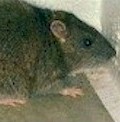Since the 1800’s, rats were domesticated and selectively bred for coat color, temperament, and longevity. For prior centuries, Asians kept the brown rat. Both wild and domestic rats are good climbers, diggers, jumpers, chewers, and swimmers. They communicate among themselves through scent, sound, touch, and visual signals. But, domestics are more docile, trusting, calmer, don’t bite (if properly trained and not extremely agitated), and disease-free. Rats are very clean, very intelligent, small, social pets.
The fancy rat or pet rat is a domesticated breed of the brown rat (Rattus novegicus) or, more rarely, of the black rat (Rattus rattus). The name “fancy rat” has nothing to do with the “fanciness” of their appearance but derives from the meaning of “to fancy”. Thus, one who keeps pet rats is said to be “rat fancy.”
Specially bred as pets at least since the late 19th century, the rats are sociable, intelligent animals and can be trained to use a litter box, come when called, and perform a variety of tricks. Pet rats behave differently than their wild relatives depending on how many generations they have been removed, and, when acquired from a reliable source, they do not pose any more health risk than other, more common pets. Pet rats live about 2.5-3 years, although the oldest rat on record, a lab rat called Rodney, reached a purported age of 7 years and 4 months. Buck (male rats) reach an average weight of 400-800 g, while does (female rats) range from 250-450 g. Female rats tend to be more active than male rats.
All rats are social animals, and fancy rats are no exception. It is common for rats to groom each other and sleep together. As with dogs, rats create a hierarchy, and each rat has its own place in the pack. There is always a dominant rat. Fancy rats, as with wild rats, are nocturnal. Groups of pets tend to “play fight” which can involve any combination of jumping, chasing, tumbling, and boxing. Play fighting involves rats going for each other’s necks, while serious fighting strikes at each other’s back ends.
It was discovered that rats emit short, high frequency, ultrasonic, socially induced vocalization during rough and tumble play, and when tickled. The vocalization is described as “chirping.” Humans cannot hear the “chirping” without special equipment. It was also discovered that, like humans, rats have “tickle skin,” certain areas of the body that generate more laughter response than other areas. Certain studies found that rats can laugh and express joy. Rats chirp when wrestling one another and before receiving morphine or having sex. The sound has been interpreted as an expectation of something rewarding.
Fancy rats being defined, as a purely domesticated subset of Rattus novegicus or Rattus rattus, are more prone to specific health concerns and diseases than their wild counterparts. Conversely they are also far less likely to succumb to certain illnesses that are prevalent in the wild. The major consideration for susceptibility includes exposure, living conditions, and diet. Rats that live their entire lives indoors are able to avoid disease-causing bacteria such as Salmonella and Pseudomoas aeruginosa, the later being absent in treated water. They may also easily avoid vectors like cockroaches, beetles, and fleas that are essential for the spread of Bubonic plague and intestinal cestodes like Rat tapeworms.
Additionally, pet or laboratory rats enjoy the natural benefits of having a consistent and well-balanced diet. However, this could be countered with the fact that outside of the laboratory rats may not always be receiving proper nutrition. Lab blocks are excellent source of nutrition for rats. Finally, rats that are in the care of humans have access to surgery for the benign mammary tumors that are common to both sexes. While living indoors decreased the risk of contacting certain diseases, living in close quarters with other rats, being unable to always seek proper protection from environmental factors (e.g., temperature, humidity, drafts), being fed an unhealthy diet, and the stresses naturally associated with living in an unnatural habitat can all have adverse effects on the rat’s health making them prone to specific conditions.
